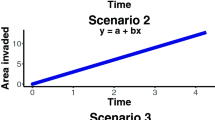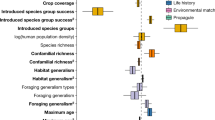Abstract
The tens rules states that 10 % of all introduced species establish and about 10 % of those species become invasive. Several studies have failed to support the tens rule. However, these studies are beset by a general weakness: many unsuccessful invasions are never reported, and without these data tests of the tens rules are inadequate. Here, using data on the establishment success of non-native birds in Hawaii and Britain and comparing these data with those from a previous study, we show that lack of information about failed species introductions, and the tendency to report species that have become invasive more than those that have not, result in an overestimate of the establishment success and invasion rates of non-native species.
Similar content being viewed by others
References
Case TJ (1996) Global patterns in the establishment and distribution of exotic birds. Biol Conserv 78:69–96
Dudley SP (2005) Changes to category C of the British list. Ibis 147:803–820
Heinzel H, Fitter R, Parslow J (1972) The birds of Britain and Europe. Collins, London
Jeschke JM (2008) Across islands and continents, mammals are more successful invaders than birds. Divers Distrib 14:913–916
Jeschke JM (2009) Across islands and continents, mammals are more successful invaders than birds (Reply to Rodriguez-Cabal et al.). Divers Distrib 15:913–914
Jeschke JM, Strayer DL (2005) Invasion success of vertebrates in Europe and North America. Proc Natl Acad Sci USA 102:7198–7202
Lever C (1987) Naturalized birds of the world. Longman, London
Pyle RL, Pyle P (2009) The birds of the Hawaiian islands: occurrence, history, distribution, and status. B.P. Bishop Museum, Honolulu, HI, USA Version 1 (31 December 2009) http://hbs.bishopmuseum.org/birds/rlp-monograph
Ridpath MG, Moreau RE (1966) The birds of Tasmania: ecology and evolution. Ibis 108:343–349
Rodriguez-Cabal MA, Barrios-Garcia MN, Simberloff D (2009) Across islands and continents, mammals are more successful invaders than birds (Reply). Divers Distrib 15:911–912
Simberloff D (1995) Why do introduce species appear to devastate islands more than mainland areas? Pac Sci 49:87–97
Simberloff D, Boecklen W (1991) Patterns of extinction in the introduced Hawaiian avifauna: a reexamination of the role of competition. Am Nat 138:300–327
Sol D (2000) Are islands more susceptible to be invaded than continents? Birds say. Ecography 23:678–692
Williamson M (1993) Invaders, weeds and the risk from genetically manipulated organisms. Experientia 49:219–229
Williamson M (1996) Biological invasions. Chapman & Hall, London
Williamson M (2006) Explaining and predicting the success of invading species at different stages of invasions. Biol Invasions 8(1561):1568
Williamson M, Brown KC (1986) The analysis and modelling of British invasions. Philos Trans R Soc Lond B 314:505–522
Acknowledgments
Two anonymous referees provided useful comments on a previous draft of this manuscript.
Author information
Authors and Affiliations
Corresponding author
Electronic supplementary material
Below is the link to the electronic supplementary material.
Rights and permissions
About this article
Cite this article
Rodriguez-Cabal, M.A., Williamson, M. & Simberloff, D. Overestimation of establishment success of non-native birds in Hawaii and Britain. Biol Invasions 15, 249–252 (2013). https://doi.org/10.1007/s10530-012-0285-y
Received:
Accepted:
Published:
Issue Date:
DOI: https://doi.org/10.1007/s10530-012-0285-y




